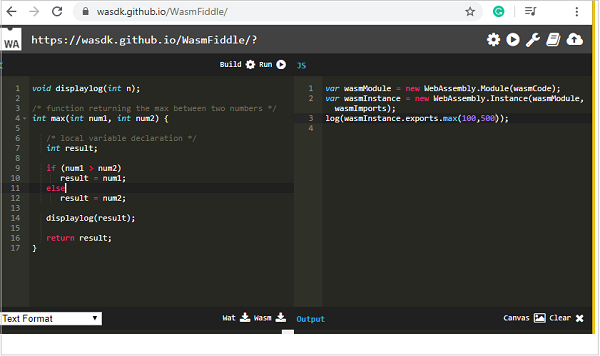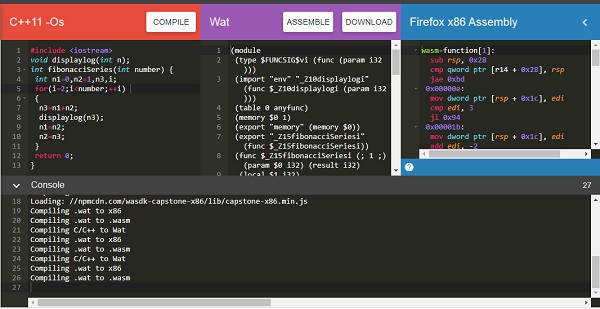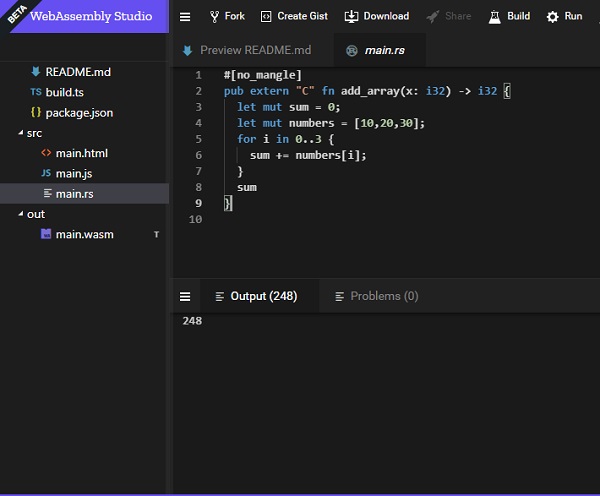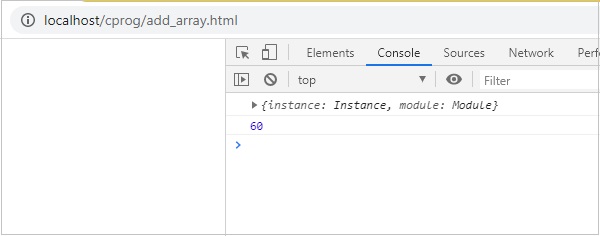
- WebAssembly 教程
- WebAssembly - 主页
- WebAssembly - 概述
- WebAssembly - 简介
- WebAssembly-WASM
- WebAssembly - 安装
- WebAssembly - 编译为 WASM 的工具
- WebAssembly - 程序结构
- WebAssembly - JavaScript
- WebAssembly - Javascript API
- WebAssembly - 在 Firefox 中调试 WASM
- WebAssembly - “你好世界”
- WebAssembly - 模块
- WebAssembly - 验证
- WebAssembly - 文本格式
- WebAssembly - 将 WAT 转换为 WASM
- WebAssembly - 动态链接
- WebAssembly - 安全
- WebAssembly - 使用 C
- WebAssembly - 使用 C++
- WebAssembly - 使用 Rust
- WebAssembly - 使用 Go
- WebAssembly - 使用 Nodejs
- WebAssembly - 示例
- WebAssembly 有用资源
- WebAssembly - 快速指南
- WebAssembly - 有用的资源
- WebAssembly - 讨论
WebAssembly - 示例
本章讨论有关 WebAssembly 的示例。
实施例1
以下是获取最大元素的 C 程序示例 -
void displaylog(int n);
/* function returning the max between two numbers */
int max(int num1, int num2) {
/* local variable declaration */ int result;
if (num1 > num2)
result = num1;
else result = num2;
displaylog(result);
return result;
}
在 wasm fiddle 中编译代码并下载 .wasm 和 .wat 代码。

笏代码
Wat 代码如下 -
(module
(type $FUNCSIG$vi (func (param i32)))
(import "env" "displaylog" (func $displaylog (param i32)))
(table 0 anyfunc)
(memory $0 1)
(export "memory" (memory $0))
(export "max" (func $max))
(func $max (; 1 ;) (param $0 i32) (param $1 i32) (result i32)
(call $displaylog
(tee_local $0
(select
(get_local $0)
(get_local $1)
(i32.gt_s (get_local $0) (get_local $1))
)
)
)
(get_local $0)
)
)
下载 .wasm 代码并让我们在 .html 文件中使用,如下所示 -
<!DOCTYPE html>
<html>
<head>
<meta charset="UTF-8">
</head>
<body>
<script>
const importObj = {
env: {
displaylog: n => alert("The max of (400, 130) is " +n)
}
};
fetch("testmax.wasm") .then(bytes => bytes.arrayBuffer())
.then(module => WebAssembly.instantiate(module, importObj))
.then(finalcode => {
console.log(finalcode);
console.log(finalcode.instance.exports.max(400,130));
});
</script>
</body>
</html>
输出
输出如下 -

实施例2
以下是获取给定数字的斐波那契数列的 C++ 代码。
#include <iostream>>
void displaylog(int n);
int fibonacciSeries(int number) {
int n1=0,n2=1,n3,i;
for(i=2;i<number;++i) {
n3=n1+n2; displaylog(n); n1=n2; n2=n3;
}
return 0;
}
我正在使用 wasm explorer 来编译代码。下载 Wat 和 Wasm 并在浏览器中进行测试。

您可以使用下面提到的代码 -
<!DOCTYPE html>
<html>
<head>
<meta charset="UTF-8">
</head>
<body>
<script>
const importObj = {
env: { _Z10displaylogi: n => console.log(n) }
};
fetch("fib.wasm")
.then(bytes => bytes.arrayBuffer())
.then(module => WebAssembly.instantiate(module, importObj))
.then(finalcode => {
console.log(finalcode);
console.log(finalcode.instance.exports._Z15fibonacciSeriesi(10));
});
</script>
</body>
</html>
输出
输出如下 -

实施例3
以下是在给定数组中添加元素的 Rust 代码。
fn add_array(x: i32) -> i32 {
let mut sum = 0;
let mut numbers = [10,20,30]; for i in 0..3 {
sum += numbers[i];
}
sum
}
我们将使用 WebAssembly Studio 将 RUST 编译为 wasm。

构建代码并下载 wasm 文件并在浏览器中执行相同的操作。
<!DOCTYPE html>
<html>
<head>
<meta charset="UTF-8">
</head>
<body>
<script>
const importObj = {
env: {
}
};
fetch("add_array.wasm") .then(bytes => bytes.arrayBuffer())
.then(module => WebAssembly.instantiate(module, importObj))
.then(finalcode => {
console.log(finalcode);
console.log(finalcode.instance.exports.add_array());
});
</script>
</body>
</html>
输出
输出如下 -
